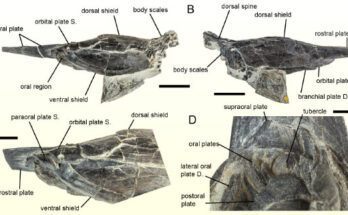Astronomers utilizing CSIRO’s Parkes radio telescope (Murriyang) have detected uncommon radio indicators from XTE J1810-197, a radio magnetar (ultra-magnetic neutron star) positioned 8,100 light-years away within the constellation of Sagittarius.

An artist’s impression of the radio magnetar XTE J1810-197. Picture credit score: Carl Knox, OzGrav / Swinburne College of Know-how.
Magnetars are a kind of neutron star and the strongest magnets within the Universe.
Most are recognized to emit polarised mild, although the sunshine this magnetar is emitting is circularly polarized, the place the sunshine seems to spiral because it strikes by way of area.
“The outcomes are surprising and completely unprecedented,” stated Dr. Marcus Decrease, an astronomer at CSIRO.
“In contrast to the radio indicators we’ve seen from different magnetars, this one is emitting huge quantities of quickly altering round polarization. We had by no means seen something like this earlier than.”
“Finding out magnetars affords insights into the physics of intense magnetic fields and the environments these create,” stated Dr. Manisha Caleb, an astronomer on the College of Sydney.
“The indicators emitted from this magnetar indicate that interactions on the floor of the star are extra advanced than earlier theoretical explanations.”
XTE J1810-197 is one in every of solely a handful recognized to provide radio pulses.
Whereas it’s not sure why this magnetar is behaving so in another way, the examine authors have an concept.
“Our outcomes recommend there’s a superheated plasma above the magnetar’s magnetic pole, which is performing like a polarising filter,” Dr. Decrease stated.
“How precisely the plasma is doing that is nonetheless to be decided.”
XTE J1810-197 was first noticed to emit radio indicators in 2003. Then it went silent for effectively over a decade.
The indicators had been once more detected by the College of Manchester’s 76-m Lovell telescope on the Jodrell Financial institution Observatory in 2018 and rapidly adopted up by Murriyang, which has been essential to observing the magnetar’s radio emissions ever since.
The 64-m diameter telescope on Wiradjuri Nation is provided with a innovative ultra-wide bandwidth receiver.
The receiver was designed by CSIRO engineers who’re world leaders in creating applied sciences for radio astronomy functions.
The receiver permits for extra exact measurements of celestial objects, particularly magnetars, as it’s extremely delicate to adjustments in brightness and polarisation throughout a broad vary of radio frequencies.
“Research of magnetars resembling these present insights into a variety of utmost and strange phenomena, resembling plasma dynamics, bursts of X-rays and gamma-rays, and probably quick radio bursts,” the astronomers stated.
The examine was revealed within the journal Nature Astronomy.
_____
M.E. Decrease et al. Linear to round conversion within the polarized radio emission of a magnetar. Nat Astron, revealed on-line April 8, 2024; doi: 10.1038/s41550-024-02225-8



